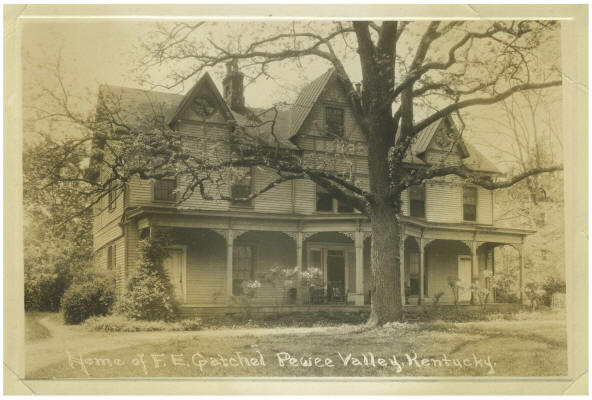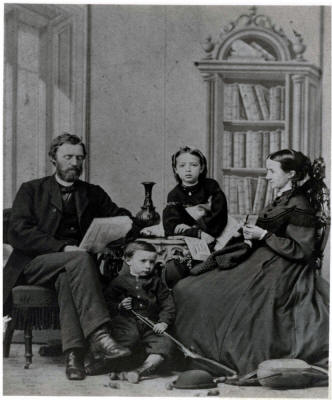“Woodside (or Wayside)”
The Old Gatchel Place”
Woodside or Wayside as it was incorrectly labeled on the map created by the people of Pewee Valley for the “Little Colonel” movie.
The same incorrect name also appears on the Little Colonel game board
Although Woodside appears on both the Little Colonel movie map and game board, we do not believe it was ever mentioned by Annie Fellows Johnston in the Little Colonel series.
The Gothic Revival-style house, located at 110 Central Avenue, was built about 1857 by Nanette Brown Price Smith, according to information provided to the National Register of Historic Places by Carol B. Tobe in 1982:
“In 1856, Thomas Marshall, trustee for his sister-in-law, Nanette Smith, purchased an 8-3/4-acre tract for her in Pewee Valley. It was part of the land of Pewee Valley pioneers, Henry and Susan Smith. The house was probably built soon after…
Nanette Brown Price Smith (1798-1878) was married to Thomas Smith (1787-1866). Nanette’s mother, Susannah Hart Price, was the sister of Lucretia (Mrs. Henry) Clay. Thomas Marshall, husband of Nanette’s sister Eliza, was Chief Justice of the Court of Appeals and a teacher at Transylvania For more on the Clay family genealogy, see Ancestry of Henry Clay (1777 – 1852).
Thomas Smith was a Lexington newspaper editor and a prominent man in that city. He purchased the “Kentucky Gazette” in 1809 when he was only 20. After five years, he sold the “Gazette” and joined with his brother-in-law, William Worsley, in publication of the “Reporter.”
Thomas Smith served as President of the Lexington and Frankfort Railroad, Kentucky’s first railroad to pass through Pewee Valley. Woodside may have been Smith’s retirement home and several associations suggest why he may have chosen Pewee Valley. Another prominent Lexingtonian, Elisha Warfield, was connected with the railroad and owned property in Pewee Valley. Louisville newspaper publisher Walter Haldeman built his home Edgewood next door to the Thomas Smiths.
In the 1860 census, Edwin Bryant is listed as living with Thomas and Nanette Smith. Bryant and a partner had purchased the “Reporter” from Smith in 1832 and he was later to manage the “Louisville Dime” with Walter Haldeman.
The Smiths sold Woodside in 1865 but may have continued to live there, or somewhere in Pewee Valley, as Thomas died there in 1866 and Nanette’s will, written in 1877, states that she resides in Pewee Valley. Thomas and Nanette had no children.
Although there is some confusion about the Thomas Smiths’ residence, it seems safe to say that they lived, at least for a time, at Woodside. The notes of James A. Miller, who settled in Pewee Valley in 1850, mention that Thomas Smith purchased the property at Muir Lane and the railroad (Oak Lea); however, the 1858 Bergman map of Jefferson County has Edwin Bryant located on the Oak Lea property and Thomas Smith at Woodside. In the 1860 census, Bryant and the Smiths were residing together in the same house. The 1879 Beers and Lanagan Atlas identifies the Central Avenue property as Woodside and Woodside is mentioned as the home of Thomas Smith in the 1858 publication “Antiquitates Peweeji.”
James A. Miller’s notes also state that Nanette Smith was the sister of Mrs. Henry Clay and raised the three orphaned children of Henry Clay, Jr. Actually, it was Nanette’s mother who was the sister of Mrs. Henry Clay. The three children of Nanette’s cousin, Henry Clay, Jr., were orphaned. Their mother died in 1840 and their father was killed in the Mexican War in 1847 so it is possible they were raised by Mrs. Smith.
In Miller’s reminiscences he says that the Clay children were Henry, Thomas and Nanette. The boys, he states, were killed in the Civil War and the girl married H.C. McDowell of Louisville, who was later to buy the Clay homestead, Ashland. Clay family history confirms all this. Henry was a Union soldier; Thomas, a Confederate; and both died during the war. The daughter Ann (not Nanette) married Henry Clay McDowell in 1857.
Thomas S. Kennedy of Crescent Hill, a descendent of Thomas Smith’s sister, Jane, who married Matthew Kennedy, wrote the following profile of Colonel Thomas Smith of Louisville, Kentucky in 1897:
Thomas Smith was born in Richmond, Va. about 1792. His father was Captain Samuel Smith, a revolutionary officer, who had married Tabitha McLaughlin and resided on Church Hill, near the old Swan Tavern, a famous resort at the time for prominent men; among the number was Chief Justice Marshall, who was a friend and neighbor of Capt. Samuel Smith’s.
Col. Thomas Smith’s twin sister, Rebecca, married William W. Worsley, who in copartnership with Ritchie, edited the “Richmond Enquirer.” In the printing office of the “Enquirer” young Smith learned to be a printer; and in after years, in order to distinguish himself from others of the same name and post office address, he always signed his name, “Thomas Smith (P)” and had all letters to him thus directed. Whenever asked what the “P” stood for, he would with great gusto replay, “for the Printer – Thomas Smith, Printer.”
In about 1810 Thomas Smith’s mother, then a widow, removed with her family … to Lexington, Kentucky…When quite a young man, living in Lexington, Thomas Smith joined the Kentucky troops and fought in the battle of Raisin River (War of 1812), where the Americans, under Cols. Allen and Lewis and Gen. Winchester were disastrously defeated by the British and Indians in 1813.
Returning from the war, young Smith was employed on the “Lexington Observer & Reporter,” then owned and edited by (his brother-in-law) Mr. Worsley. In a few years, he became associate editor and in 1825, when Mr. Worsley removed to Louisville, Thomas Smith (P) became the proprietor and editor of the “Observer & Reporter.” This weekly newspaper was the personal organ of Henry Clay, whose residence called Ashland was only a short mile from the Courthouse in Lexington. Mr. Smith had married Niss Nanette Price, a sister to the wife of Chief Justice Thomas A. Marshall of the Kentucky Court of Appeals and these sisters were nieces of Mrs. Henry Clay and of Mrs. U.S. Senator Brown and Mrs. Thomas Hart and Mrs. John W. Hunt…The office of the “Observer & Reporter” was in Jordan’s Row and just opposite the eastern side of the courthouse. Mr. Clay always made this office his headquarters when in town and so continued until Mr. Smith sold the newspaper, about in 1838, to Edwin Bryant, a cousin to the poet, W.C. Bryant. Mr. Smith was very kind to Mr. Bryants. He took him to his home when he came to Kentucky, a young man in search of employment; and gave him a position in his office. Mr. Bryant ever after remained with mr. Smith and lived at his house or made it his home for many years even until his decease in the 1860s. When Mr. Smith removed to Louisville in 1848, Mr. Bryant came also and soon after organized an overland company to California. On arrival at San Francisco, Major Bryant was elected to the office of alcade serving for about a year. He made some fortunate real estate investments in San Francisco; and by leasing the lands he obtained a handsome income and a valuable property. Judge Bryant, as he was familiarly called, returned in 1850 to Louisville, and again made his home with his friend, Col smith, and fully repaid him for the aid given him when he was a poor boy looking for work. Judge Bryant never married. He was engaged in other newspaper work in Lexington and Louisville.
…Mr. Smith, upon the removal of Mr. Worsley from Lexington, continued the publication of “The Observer & Reporter.”
…All during his life he was ever engaged in building homes and in improving the rural grounds surrounding him. He preferred suburban residences and after planting and plotting the grounds into handsome style, he would sell at a good profit and commence the building up of a new home on a larger and more attractive scale. Thus at Lexington he owned The Villa, a very attractive public resort which he built while he was president of the Lexington and Frankfort railroad…After the Villa…Mr. Smith then bought and improved the Trotter farm which he called Westbrook. Then again he built a cottage home nearly opposite Ashland which he called Woodside where he lived until he removed to Louisville.
Soon after coming to Louisville he made up a party of clever men and bought land about 16 miles from the city of the LC&L railroad. They each built a suburban villa residence. Among the party were Col. Smith and his friendJudge Bryant; W. N. Haldeman of the “Courier-Journal,” W. D. Gallagher, the poet; Prof. Noble Butler, the author and others. The settlement was named Pewee Valley, although it is located on top of a ridge 450 feet above Louisville. There Col. Smith built up and improved three different home places and the settlement is now one of the best and most delightful of all the suburbs about Louisville…
In 1839 Col Smith formed a co-partnership with his brother-in-law, Mr. Matthew Kennedy and his two sons. The commercial firm was styled Kennedy, Smith & Co… and engaged in selling bagging and rope manufactured at the factories in Kentucky, to the cotton planters’ agents at New Orleans, Mobile and Charleston, S.C.; also the firm sold New Orleans sugar…; and they sold coffee imported direct from Rio de Janeiro…
…He died at his residence on Third Street near Kentucky in Louisville and his body was interred in the beautiful cemetery at Lexington, almost under shadow of the splendid monument erected over the earthly remains of his friend, “the great commoner” Henry Clay….
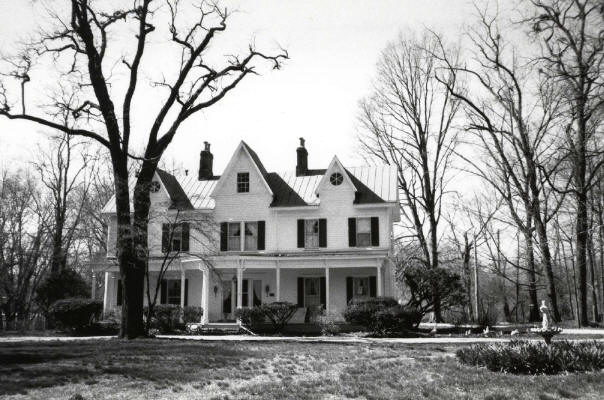
Woodside, with its woods intact, 1990s
Photo from “Historic Pewee Valley”
Alex Luken has found information that indicates that Nanette Brown Price Smith was Thomas Smith’s second wife. He was married first to Mary Darnall Henson on October 7, 1803 in North Carolina.
She also notes that his role in newspaper publishing is the subject of historical debate. Some sources, including JSTOR articles, list him as Editor & Publisher of the “Lexington Reporter,” while the “History of Printing in America,” written by Isaiah Thomas in 1874, links him to the “Kentucky Gazette.” According to The Papers of Henry Clay, Thomas Smith succeeded John Bradford as the editor of the Kentucky Gazette in 1809. In 1814, he and his partner Joseph Beckley sold out to Fielding Bradford, Jr. . In 1816, Thomas Smith joined his brother-in-law William W. Worsley as publisher of the “Lexington Reporter,” which was renamed the “Kentucky Reporter.”
The Draper Collection has letters from Thomas Smith to William W. Worsley during the war of 1812.
Pewee Valley resident B. Utley Murphy, whose parents owned Woodside from 1949-1976, notes that Thomas’ wife, Nanette, was responsible for the couple’s many real estate transactions in Pewee Valley, possibly because he could not be trusted with money. Every piece of real estate the couple owned in Pewee Valley was in Nanette’s name and was purchased through her brother-in-law and financial advisor, Thomas Marshall. Edwin Bryant’s will supports this contention, since he leaves no money to his good friend Thomas, but makes two $5,000 bequests to Nanette.
**************
Woodside changed hands a number of times until it was purchased by Francis Edwin Francis Edwin Gatchel and his wife, Alice Craig Gatchel, in 1907. The Gatchel family is Woodside’s “Little Colonel” connection. Alice Craig Gatchel was the granddaughter of Annie Craig, Annie Fellows Johnston’s model for Mrs. McIntyre in the series. Alice’s mother, Alice Craig, had married Austin Peay in 1880 and died a year later on December 13, 1881, less than two months after giving birth to her daughter.
There’s a poignant story connected to Alice Craig Peay’s death. At the time of her final illness, her sister, Mary(Mamie) Craig, had recently become engaged to army Captain (later General) Henry Ware Lawton. Sensing the end was near, Alice begged her sister to marry quickly so she would be able to attend the wedding. Mamie quickly telegraphed Henry and he obtained leave and left for Louisville by special train. Their wedding took place on December 12, 1881 at Alice’s death bed. Alice died the next day. Mamie Craig Lawton, her husband and their children later became Annie Fellows Johnston’s models for the Waltons in the Little Colonel series.
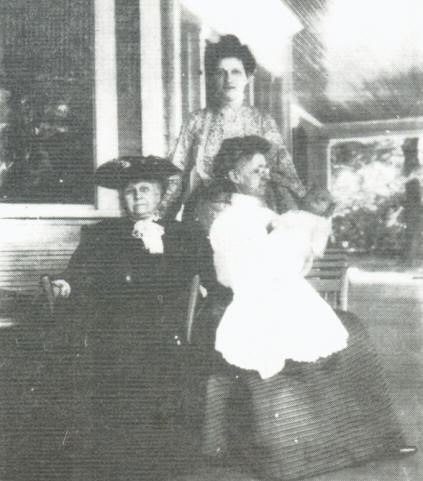
Alice Craig Gatchel, standing, with her grandmother, Annie Craig,
and Aunt Fanny Craig holding Alice’s daughter, Frances C. Gatchel.
The photo appears to have been taken on the front porch of The Beeches,
which was built and owned by Alice Gatchel’s Aunt Mary “Mamie” Lawton.
Alice Craig Gatchel was raised by her grandmother and her Aunt Fanny Craig at Edgewood, just down Central Avenue from Woodside. Her name was also changed from Alice Craig Peay to Alice Craig. We have been unable to find any trace of her father, Austin Peay.
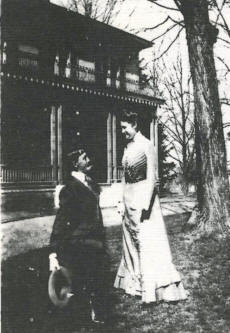
Frank and Alice Gatchel standing in front of Edgewood, Alice’s childhood home.
From “The Land of the Little Colonel” published in 1974 by Katy Smith
In 1903, Alice married Frank Gatchel, a member of the family photography business, W.D. Gatchel & Sons. The firm was founded in Cincinnati in 1862 by Welcome D. Gatchel. According to family tradition, his middle initial stood for “Darling,” making his name Welcome Darling Gatchel. W.D. and his wife, Frances, had a daughter, Mary, and two sons: Francis Edwin or Frank and Albert Durfee or Bert. The photo below, taken in Cincinnati, shows the Gatchel family before Albert was born.
A Louisville branch of W. D. Gatchel’s & Sons was established in 1870, with the purchase of a camera store. Frank later served as president in Louisville, and his brother Bert, who married Caroline Letitia Forwood or “Daisy,” in January 1890, moved to Birmingham, Alabama and established another branch for the company there known as Gatchel’s Photo Stock House.
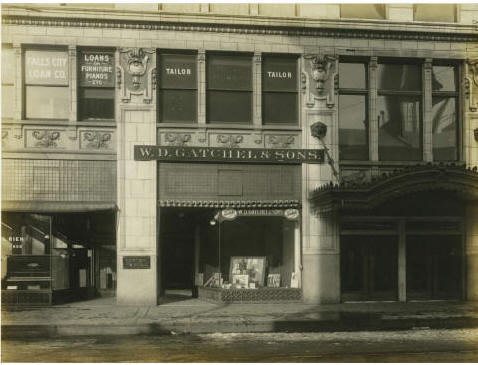
Oldest known photo of W. D. Gatchel & Sons’ storefront in downtown Louisville, circa 1940
Republic Building, Walnut St (now Muhammad Ali) northeast corner of Walnut & 5th St = 431 W. Walnut
Frank and Alice Gatchel had two children, a daughter, Frances C., named for Frank’s mother, and a son, William Culbertson or Billy, named for Alice’s cousin, William S. Culbertson, who served as Annie Fellows Johnston’s model for Malcolm McIntyre, one of the “Two Little Knights of Kentucky.”
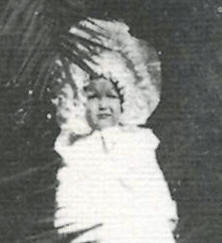
Frances Gatchel, Frank’s and Alice’s daughter.
From “The Land of the Little Colonel” published in 1974 by Katy Smith
Neither Bert nor Frank was destined to enjoy a long marriage. Bert’s wife Daisy died of typhoid fever shortly after the couple moved to Birmingham. He himself died in 1912. Alice died on March 8, 1909, leaving behind a bereaved husband and two young children. The 1910 census shows that Frances was only six years old, and Billy only two. According to “The United Presbyterian Church in Pewee Valley 1866-1966 100th Anniversary” booklet, an Aeolian organ was given to the church by Alice’s aunt and uncle, Mr. and Mrs. S .A. Culbertson, in her memory.
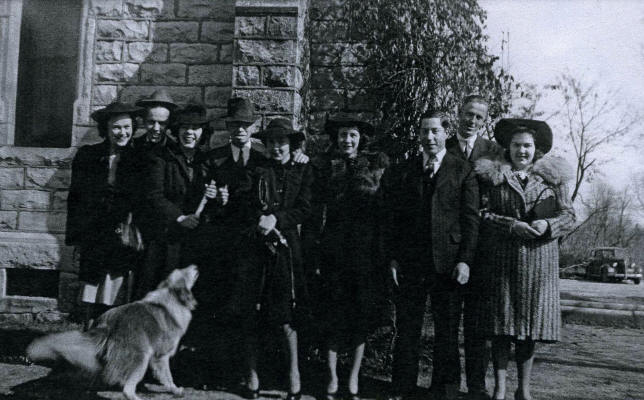
Standing in front of the Pewee Valley Presbyterian Church are: (left to right)
Singie Singer, Clayton Stoess, Louise “Sis” Herdt Marker, Frank “Gatch” Gatchell, Virginia “Gin” Herdt Chaudoin,
Jean Ann Stanforth, Tom Murphy, Franklin Walker and Mary Murphy
After Alice’s death, Frank continued to live in Woodside and work downtown at W.D. Gatchels & Sons. He frequently served as chairman of Pewee Valley’s town council and was an active member of the Pewee Valley Presbyterian Church. He raised both his children at Woodside and a muddy pair of brass-toed boots that may have once belonged to his son Billy were found hidden in the attic years later. They have since been donated to the Oldham County Historical Society.

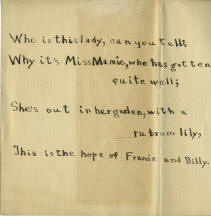
A handmade get well card from Francie and Billy Gatchel to Mary Gardner Johnston,
“Miss Mamie,” their neighbor at The Beeches
From the private collection of Suzanne Schimpeler
According to a vignette called “Christmas at Clovercroft,” originally written by Florence Dickerson for the Call of the Pewee and later reprinted on page 87 of “History by Food,” (copyright 2006 by the Oldham County Historical Society), Frank invited neighbors and friends to drop by Woodside every Christmas Eve and listen to him read aloud from Dickens’ “Christmas Carol.”
Business at the camera shop was not always the greatest. Frank’s adopted grandson, Cleve Gatchel, says his father, Billy, used to tell the tale of the Thanksgiving when financial concerns forced them to serve duck instead of turkey. When Frank got older, Cleve says, he kept a room downtown at the Watterson Apartments, between 4th and 5thstreets, where he napped after lunch. One afternoon in 1942, he went to sleep and never woke up. He and Alice are buried side by side at Cave Hill Cemetery.
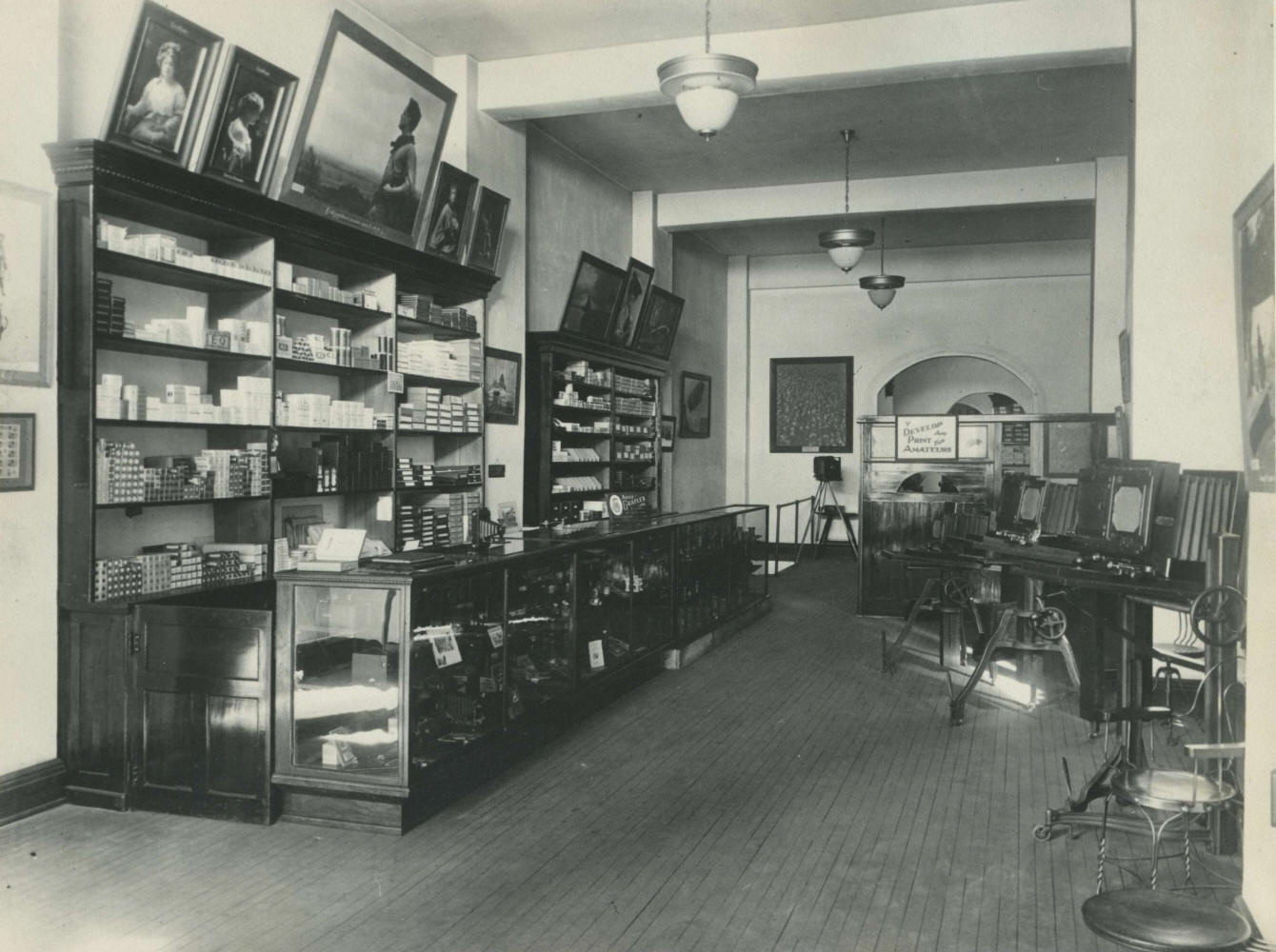
Interior of W.D. Gatchel & Sons, circa 1938
Frank’s son Billy succeeded his father as president of W.D. Gatchel and served until his death in 1953, when the small plane he was piloting crashed between Evansville and Louisville. He was replaced as head of the company by his natural son, Frances Edwin Gatchel, II, and later, by his adopted son, Cleve. The company eventually closed its doors in 1990.
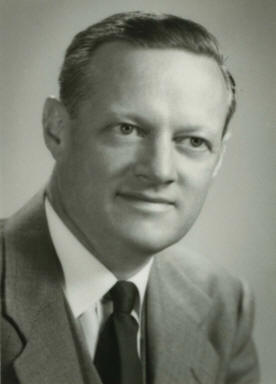
William Culbertson Gatchel, “Billy,” in 1944
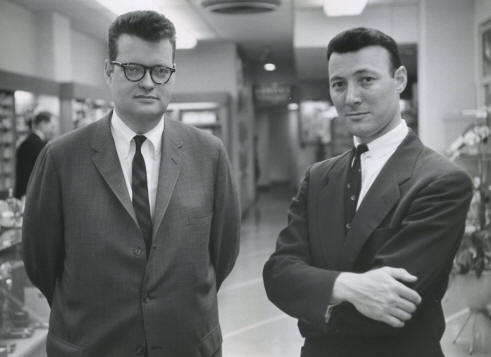
Francis Edwin Gatchel, II and Cleve Gatchel in 1962 on W.D Gatchel & Sons’
centennial. The store was then located at 431 W. Walnut Street.
Woodside remained vacant for some years after Frank’s death. It went through several changes of hands until it was purchased from Col. Earl Major by the Utley family. Several occupants have experienced paranormal activity while living there — doors that mysteriously opened and closed, furnishings that moved by themselves, and occasionally apparitions.
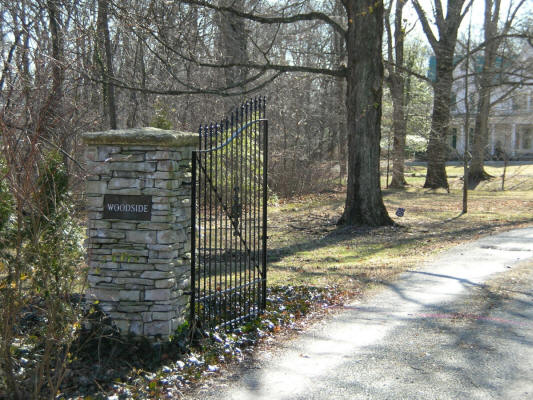
Woodside Gate (as it was in early 2007, an estate set among trees)
Today, Woodside is owned by St. Aloysius Catholic Church, which cleared nearly all the trees from the property in spring 2007 to make way for a new sports field. Pewee Valley residents tried to stop the desecration and pled their case both to the congregation and to the Archdiocese of Louisville; however, their pleas to respect Pewee Valley’s designation as a “Tree City” by keeping Woodside’s grounds intact fell on deaf ears. This is the fourth Pewee Valley landmark that St. Aloysius has defiled or destroyed since moving their church from the corner of Central Avenue and Rollington Road to Mt Mercy Avenue in 1914. They also demolished the Burge house, the old post office building on Central Avenue, and the J. T. Moore house shown on the ca. 1880 Pewee Valley map.
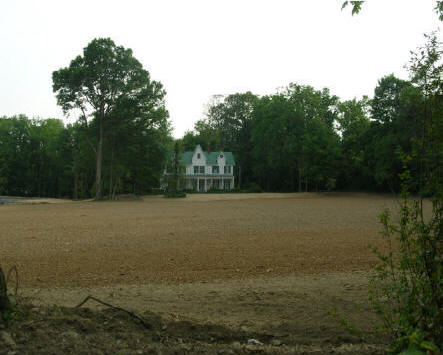
Woodside no longer lives up to its name, since St. Aloysius Church chopped
down all the trees to make way for a sports field
Late spring, 2007
In her autobiography, “Land of the Little Colonel” (1929) Annie Fellows Johnston noted she was quite upset about the changes she found in her beloved Pewee Valley when she returned there after her son John died. One of the things she mentioned was the loss of Oaklea’s famous oaks after the Muirs sold the family’s long-time summer home:
“…Oaklea had been sold and its new owner had cut down all the beautiful oak trees that gave the place its name.”
We wonder what she would think today about what’s happening at Woodside, her former neighbor just down the road on Central Avenue.
– – Many thanks to Cleve Gatchel for sharing his family photos and memories and to B. Utley Murphy for her historical research on Woodside.
page by Donna Russell
